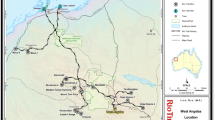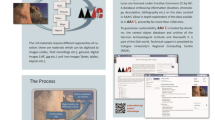Abstract
The use of digital technology to enhance and manipulate photographs of rock paintings affords researchers insights into imagery that was formerly invisible or obscure. Image enhancement and manipulation software have greatly increased the data set available for study. There is a wide range of techniques available in the digital repertoire, depending on the aim of the research. Here, three South African case studies are discussed in which hunter-gatherer rock paintings are enhanced and manipulated to create digital “tracings” using the computer programmes Adobe Lightroom, Adobe Photoshop and DStretch. The results obtained with these simple techniques are presented here, because they might prove useful for rock art research elsewhere in the world. It must be noted, however, that these technological developments do not eliminate the subjective nature of recording and interpreting rock art or the necessity of a theoretical framework in which to understand the imagery.
Résumé
Les technologies de traitement des images numériques, appliquées aux photographies d’art rupestre, offrent aux chercheurs de nouveaux moyens de voir ce qui, auparavant, était invisible ou difficile à identifier à l’œil nu. Il existe en effet une grande palette d’outils numériques adaptés à la recherche et les logiciels photographiques ont ainsi considérablement accru les bases de données susceptibles d’être analysées. Nous étudierons ici trois exemples de peintures rupestres de chasseurs-cueilleurs localisées dans des sites sud-africains, où le recours aux logiciels Adobe Lightroom, Adobe Photoshop et DStretch a permis de créer des «tracés» digitaux. Les résultats présentés montrent toute l’utilité de techniquesassez simples d’usage et qui peuvent être mises en œuvre pour l’étude de l’art rupestre ailleurs dans le monde. Il importe néanmoins de garder à l’esprit que ces avancées technologiques n’éliminent ni la dimension subjective de l’analyse et de l’interprétation de l’art rupestre, ni la nécessité de disposer d’un cadre théorique permettant la compréhension de ces images.











Similar content being viewed by others
References
Davies, O. (1974). Excavations at the walled Early Iron Age site in Moor Park near Estcourt, Natal. Annals of the Natal Museum, 22(1), 289–323.
Guy, R. D. (1970). Man and bee in southern Africa. South African Bee Journal, 42(40), 2–6.
Guy, R. D. (1972). The honey hunters of southern Africa. Bee World, 53(4), 159–166.
Hollmann, J. C. (2015a). Allusions to agriculturist rituals in hunter-gatherer rock art? eMkhobeni Shelter, northern Ukhahlamba-Drakensberg, KwaZulu-Natal, South Africa. African Archaeological Review, 32(3), 505–535. https://doi.org/10.1007/s10437-015-9197-4.
Hollmann, J. C. (2015b). Bees, honey and brood: Southern African hunter-gatherer paintings of bees and bees’ nests, uKhahlamba-Drakensberg, KwaZulu-Natal, South Africa. Azania: Archaeological Research in Africa, 50(3), 343–371. https://doi.org/10.1080/0067270X.2015.1079378.
Hollmann, J. C., & Crause, K. (2011). Digital imaging and the revelation of ‘hidden’ rock art: Vaalekop Shelter, KwaZulu-Natal. Southern African Humanities, 23, 55–76.
Le Quellec, J. L., Duquesnoy, F., & Defrasne, C. (2015). Digital image enhancement with Dstretch: Is complexity always necessary for efficiency? Digital Applications in Archaeology and Cultural Heritage, 2, 55–67. https://doi.org/10.1016/j.daach.2015.01.003.
Lewis-Williams, J. D. (1981). The thin red line: Southern San notions and rock paintings of supernatural potency. South African Archaeological Bulletin, 36, 5–13.
Lewis-Williams, J. D. (1983). Introductory essay: Science and rock art. South African Archaeological Society Goodwin Series, 4, 3–13.
Lewis-Williams, J. D. (2010). The imagistic web of San myth, art and landscape. Southern African Humanities, 22, 1–18.
Lewis-Williams, J. D. (2015). Myth and meaning: San-Bushman folklore in global context. Walnut Creek: Left Coast Press.
Lewis-Williams, J. D., & Challis, S. (2010). Truth in error: An enigmatic 19th century San comment on southern African rock paintings of ‘lions’ and ‘shields’. Before Farming, 2010(1), 1–13.
Lewis-Williams, J. D., & Dowson, T. A. (1989). Images of power: Understanding Bushman rock art. Johannesburg: Southern Book Publishers.
Maggs, T. (1982). Mgoduyanuka: Terminal Iron Age settlement in the Natal grasslands. Annals of the Natal Museum, 25(1), 83–113.
Mazel, A. D. (1982). Distribution of painting themes in the Natal Drakensberg. Annals of the Natal Museum, 25(1), 67–82.
Mguni, S. (2001). Research into the formlings in the rock art of Zimbabwe. Antiquity, 75(290), 807–808.
Mguni, S. (2004). Cultured representation: Understanding ‘formlings’, an enigmatic motif in the rock-art of Zimbabwe. Journal of Social Archaeology, 4(2), 181–199.
Mguni, S. (2006). Iconography of termites’ nests and termites: Symbolic nuances of formlings in southern African San rock art. Cambridge Archaeological Journal, 16(1), 53–71.
Orton, J., & Hart, T. (2005). Heritage impact assessment: The proposed raising of the Clanwilliam Dam wall, Olifants River Valley, Clanwilliam District. Mthatha: Ninham Shand Consulting (Pty) Ltd.
Pager, H. (1971). Ndedema: A documentation of the rock paintings of the Ndedema Gorge. Graz: Akademische Druck.
Scherz, E. R. (1986). Felsbilder in Südwest-Afrika, Teil III: Die Malereien. Cologne: Böhlau Verlag.
Pager, H. (1973). Rock paintings in southern Africa showing bees and honey hunting. Bee World, 54(2), 61–68.
Woodhouse, H. C. (1987). Bees and honey in the prehistoric rock art of southern Africa. South African Bee Journal, 59(2), 36–41.
Acknowledgements
The National Research Foundation of South Africa (NRF), Grant 104644 funds this ongoing work as part of its Incentive Funding for Rated Researchers (IFRR). Previous research was carried out on a post-doctoral research grant from the NRF. I thank my colleagues and companions who have taken part in the research and documentation processes discussed here. My special thanks go to the organisers of the Conference at the British Museum and their publication of this volume. Comments by two reviewers improved this paper, for which I am grateful.
Author information
Authors and Affiliations
Corresponding author
Ethics declarations
The National Research Foundation of South Africa (NRF) funded this study. Grant 104644 funds this ongoing work as part of its Incentive Funding for Rated Researchers (IFRR). Previous research was carried out on a post-doctoral research grant from the NRF.
Conflict of Interest
The author declares that he has no conflict of interest.
Rights and permissions
About this article
Cite this article
Hollmann, J.C. Digital Technology in Research and Documentation of Hunter-Gatherer Rock Art in South Africa. Afr Archaeol Rev 35, 157–168 (2018). https://doi.org/10.1007/s10437-018-9296-0
Published:
Issue Date:
DOI: https://doi.org/10.1007/s10437-018-9296-0




